The CBA and Data Dictionary are explained in the Modelling Concepts page here: Modeling Concepts
CDS will require a main components to be able to build a service instance, Following the instructions below in the following order to onboard the Data Dictionary and CBA Package.
- Load the latest DD.json and run the . dd.sh script in rancher.
- Once this is step is completed, access the CDS UI and upload the latest CBA and execute in the following sequence:
- Enrich
- Save
- Deploy
- if upload via SDC: Click on Download and use the Enriched CBA Package to onboard via SDC Artifact Deployment for the VF Model.
Controller Blueprint Package [Deploy the cba using CDS UI by following the steps of Enrich, Save, Deploy] |
Data Dictionary |
|---|---|
|
NOTE:
|
dd UPDATES IN cds ui with processor-db1.zip |
In ONAP Dublin release, those components need to be built manually.
After building the CBA and Data Dictionary, we can use the CDS UI to add the Data Dictionary to CDS, and to deploy the CBA in CDS.
First, we logon to CDS UI using the url http://<onap_ip_address>:30497.
Choose Controller Blueprint, select file, and update Metadata, the NEXT.
Notes:
- The UI currently doesn't throw exception on failures so please have the inspection network view enable.
Enrich, Save, Publish, and finally Deploy, and you should receive a success notification.
In ONAP Dublin release, if an error happens, there's no error shown to the user, so we need to show the browser console, in order to see if there's an error while deploying the CBA.
Notes:
- There are workarounds that we need. — "Naming" - resource-assignment content in the definition file and that needs to be removed.
If we want to add one Dictionary item, we start in the CDS UI home screen, select New Resource.
Paste the Dictionary Definition JSON string and submit.
If we want to add many Dictionary items, we can create a JSON list of all the dictionary items and save them in a file called dd.json, and then run the dd.sh script below in the same folder where dd.json is located.
#!/bin/bash # Author: abdelmuhaimen.seaudi@orange.com # Usage: name this script as dd.sh, and put the data dictionaries list JSON as dd.json in the same directory, and run dd.sh # dd.sh will read the dictionary list JSON from dd.json, will output to stdout the number of Defintions found, and will start pushing them one by one to CDS DB l=`jq '.|length' dd.json` echo "Found $l Dictionary Definition Entries" i=0 while [ $i -lt $l ] do echo "i = $i" d=`jq ".[$i]" dd.json` echo $d #REPLACE <cds-ui> with the IP Address of ONAP curl 'http://<cds-ui>:30497/resourcedictionary/save' -v -X POST -H 'Content-type: application/json' -d"$d" sleep 1 echo -e "\n*****************************************\n" i=$(( $i + 1 )) done
Within the E2E automation provided by CDS, we have a capability that can generate a name for a component, like a VNF or VF Module.
This capability runs with ONAP POLICY component, where POLICY has the rule that will be used to generate the names
The override.yaml file above has an option "preload=true", that will tell the POLICY component to run the push_policies.sh script as the POLICY PAP pod starts up, which will in turn create the Naming Policy and push it.
To check that the naming policy is created and pushed OK, we can run the commands below.
bash-4.4$ curl -k --silent -X POST \
--header 'Content-Type: application/json' \
--header 'ClientAuth: cHl0aG9uOnRlc3Q=' \
--header 'Authoment: TEST' \
-d '{ "policyName": "SDNC_Policy.Config_MS_ONAP_VNF_NAMING_TIMESTAMP.1.xml"}' \
'https://pdp:8081/pdp/api/getConfig'
[{"policyConfigMessage":"Config Retrieved! ",
"policyConfigStatus":"CONFIG_RETRIEVED",
"type":"JSON",
"config":"{\"service\":\"SDNC-GenerateName\",\"version\":\"CSIT\",\"content\":{\"policy-instance-name\":\"ONAP_VNF_NAMING_TIMESTAMP\",\"naming-models\":[{\"naming-properties\":[{\"property-name\":\"AIC_CLOUD_REGION\"},{\"property-name\":\"CONSTANT\",\"property-value\":\"ONAP-NF\"},{\"property-name\":\"TIMESTAMP\"},{\"property-value\":\"_\",\"property-name\":\"DELIMITER\"}],\"naming-type\":\"VNF\",\"naming-recipe\":\"AIC_CLOUD_REGION|DELIMITER|CONSTANT|DELIMITER|TIMESTAMP\"},{\"naming-properties\":[{\"property-name\":\"VNF_NAME\"},{\"property-name\":\"SEQUENCE\",\"increment-sequence\":{\"max\":\"zzz\",\"scope\":\"ENTIRETY\",\"start-value\":\"001\",\"length\":\"3\",\"increment\":\"1\",\"sequence-type\":\"alpha-numeric\"}},{\"property-name\":\"NFC_NAMING_CODE\"},{\"property-value\":\"_\",\"property-name\":\"DELIMITER\"}],\"naming-type\":\"VNFC\",\"naming-recipe\":\"VNF_NAME|DELIMITER|NFC_NAMING_CODE|DELIMITER|SEQUENCE\"},{\"naming-properties\":[{\"property-name\":\"VNF_NAME\"},{\"property-value\":\"_\",\"property-name\":\"DELIMITER\"},{\"property-name\":\"VF_MODULE_LABEL\"},{\"property-name\":\"VF_MODULE_TYPE\"},{\"property-name\":\"SEQUENCE\",\"increment-sequence\":{\"max\":\"zzz\",\"scope\":\"PRECEEDING\",\"start-value\":\"01\",\"length\":\"3\",\"increment\":\"1\",\"sequence-type\":\"alpha-numeric\"}}],\"naming-type\":\"VF-MODULE\",\"naming-recipe\":\"VNF_NAME|DELIMITER|VF_MODULE_LABEL|DELIMITER|VF_MODULE_TYPE|DELIMITER|SEQUENCE\"}]}}",
"policyName":"SDNC_Policy.Config_MS_ONAP_VNF_NAMING_TIMESTAMP.1.xml",
"policyType":"MicroService",
"policyVersion":"1",
"matchingConditions":{"ECOMPName":"SDNC","ONAPName":"SDNC","service":"SDNC-GenerateName"},
"responseAttributes":{},
"property":null}]
In case the policy is missing, we can manually create and push the SDNC Naming policy using the commands below.
#########################################Create SDNC Naming Policies##########################################
echo "Create Generic SDNC Naming Policy for VNF"
sleep 2
echo "Create SDNC vFW Naming Policy"
curl -k -v --silent -X PUT --header 'Content-Type: application/json' --header 'Accept: text/plain' --header 'ClientAuth: cHl0aG9uOnRlc3Q=' --header 'Authorization: Basic dGVzdHBkcDphbHBoYTEyMw==' --header 'Environment: TEST' -d '{
"configBody": "{ \"service\": \"SDNC-GenerateName\", \"version\": \"CSIT\", \"content\": { \"policy-instance-name\": \"ONAP_VNF_NAMING_TIMESTAMP\", \"naming-models\": [ { \"naming-properties\": [ { \"property-name\": \"AIC_CLOUD_REGION\" }, { \"property-name\": \"CONSTANT\",\"property-value\": \"ONAP-NF\"}, { \"property-name\": \"TIMESTAMP\" }, { \"property-value\": \"_\", \"property-name\": \"DELIMITER\" } ], \"naming-type\": \"VNF\", \"naming-recipe\": \"AIC_CLOUD_REGION|DELIMITER|CONSTANT|DELIMITER|TIMESTAMP\" }, { \"naming-properties\": [ { \"property-name\": \"VNF_NAME\" }, { \"property-name\": \"SEQUENCE\", \"increment-sequence\": { \"max\": \"zzz\", \"scope\": \"ENTIRETY\", \"start-value\": \"001\", \"length\": \"3\", \"increment\": \"1\", \"sequence-type\": \"alpha-numeric\" } }, { \"property-name\": \"NFC_NAMING_CODE\" }, { \"property-value\": \"_\", \"property-name\": \"DELIMITER\" } ], \"naming-type\": \"VNFC\", \"naming-recipe\": \"VNF_NAME|DELIMITER|NFC_NAMING_CODE|DELIMITER|SEQUENCE\" }, { \"naming-properties\": [ { \"property-name\": \"VNF_NAME\" }, { \"property-value\": \"_\", \"property-name\": \"DELIMITER\" }, { \"property-name\": \"VF_MODULE_LABEL\" }, { \"property-name\": \"VF_MODULE_TYPE\" }, { \"property-name\": \"SEQUENCE\", \"increment-sequence\": { \"max\": \"zzz\", \"scope\": \"PRECEEDING\", \"start-value\": \"01\", \"length\": \"3\", \"increment\": \"1\", \"sequence-type\": \"alpha-numeric\" } } ], \"naming-type\": \"VF-MODULE\", \"naming-recipe\": \"VNF_NAME|DELIMITER|VF_MODULE_LABEL|DELIMITER|VF_MODULE_TYPE|DELIMITER|SEQUENCE\" } ] } }",
"policyName": "SDNC_Policy.ONAP_VNF_NAMING_TIMESTAMP",
"policyConfigType": "MicroService",
"onapName": "SDNC",
"riskLevel": "4",
"riskType": "test",
"guard": "false",
"priority": "4",
"description": "ONAP_VNF_NAMING_TIMESTAMP"
}' 'https://pdp:8081/pdp/api/createPolicy'
#########################################Pushing SDNC Naming Policies##########################################
echo "Pushing SDNC Naming Policies"
sleep 2
echo "pushPolicy : PUT : SDNC_Policy.ONAP_VNF_NAMING_TIMESTAMP"
curl -k -v --silent -X PUT --header 'Content-Type: application/json' --header 'Accept: text/plain' --header 'ClientAuth: cHl0aG9uOnRlc3Q=' --header 'Authorization: Basic dGVzdHBkcDphbHBoYTEyMw==' --header 'Environment: TEST' -d '{
"pdpGroup": "default",
"policyName": "SDNC_Policy.ONAP_VNF_NAMING_TIMESTAMP",
"policyType": "MicroService"
}' 'https://pdp:8081/pdp/api/pushPolicy'
Introduction
The purpose of this article is to describe the vDNS use case distribution in Dublin Release.
What's new
The Controller Blueprint Archive CBA is a zip archive that hosts all the service model related artifacts (heat templates, blueprints, vtl templates, workflows, etc ... ) that can enable ONAP to assign and instantiate the service.
Controller Design Studio CDS should receive a notification when a new service model is distributed by SDC, and then CDS will download the CBA CSAR file and deploy it.
Distribution of a VNF CBA
Login to ONAP as Designer (cs0008/demo123456!), and click on SDC application.
Part 1 - Create a New Virtual Software Product
In SDC, select the ONBOARD button > click on Create New VSP button > fill in the Name, Vendor, Category , Description and select the Network Package for on-boarding procedure as illustrated below.
Once the forum is populated for New Software Product click on Create.
In Software Product Details Screen in SDC, the users must populate the license information and the software product. For the vLB CDS use case the software product for the heat package is obtain from the following link: vLB CDS HEAT PACKAGE.
Once the for License and Software Product Attachment is populated then click on the Submit button.
Part 2 - Create VF Model and Certify
Click on the Import VSP from the HOME page.
From the list of VSP, select the Specific vLB CDS VSP for IMPORT to create the VF in SDC.
We fill in the VF name and description, etc ..., and click "Create".
Click on "Deployment Artifact", then "Add other arifacts", and select the vDNS.zip CBA.
Check the artifact is uploaded OK, and click on "Certify".
Add a comment, and submit, you should receive a success notification, and we are back in SDC Home Screen.
Part 3 - Create Service Model, Certify and Distribute
Now, let's create a new service model, and add the newly created VF (including CBA artifact) to the new service model. Click on "Add Service"
Add service name and description, and click on "Create". Choose Instantiation Type: Macro.
Click on "Composition", and drag the VF we created from the palette on the left onto the canvas in the middle.
Click on Properties Assignments, then click on the service name, e.g. "CDS-VNF-TEST" from the right bar.
Type "sdnc" in the filter box, and add the sdnc_model_name, sdnc_model_version, and sdnc_artifact_version, and click "Save".
Type "skip" in the filter box, and set "skip post instantiation" to FALSE, then click "Save".
Then, click on "Submit for Testing".
Login as Tester (jm0007/demo123456!) and accept the new service.
Login as Governor (gv0001/demo123456!) and approve for distribution.
Login as Operator (op0001/demo123456!) and click on "Distribute".
Click on "Monitor" to check the progress of the distribution, and check that all ONAP components were notified, and downloaded the artifacts, and deployed OK.
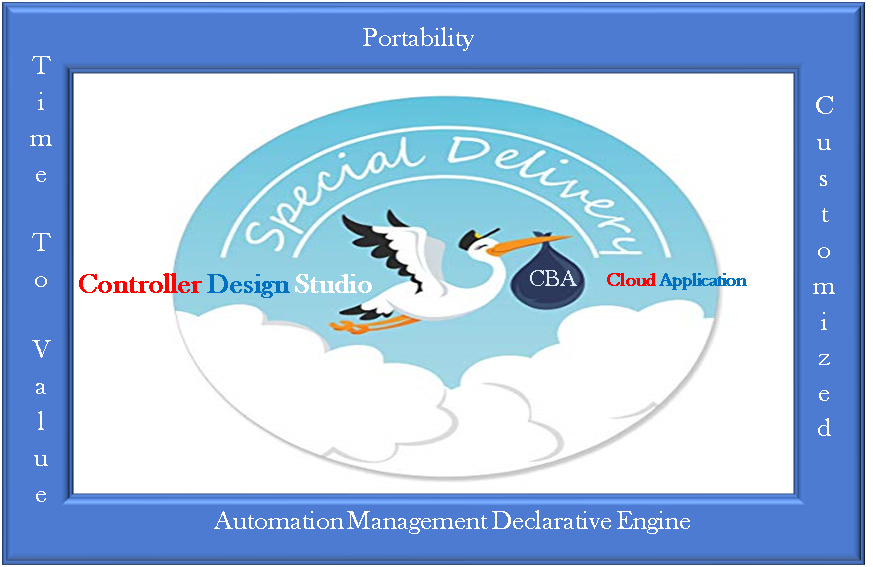
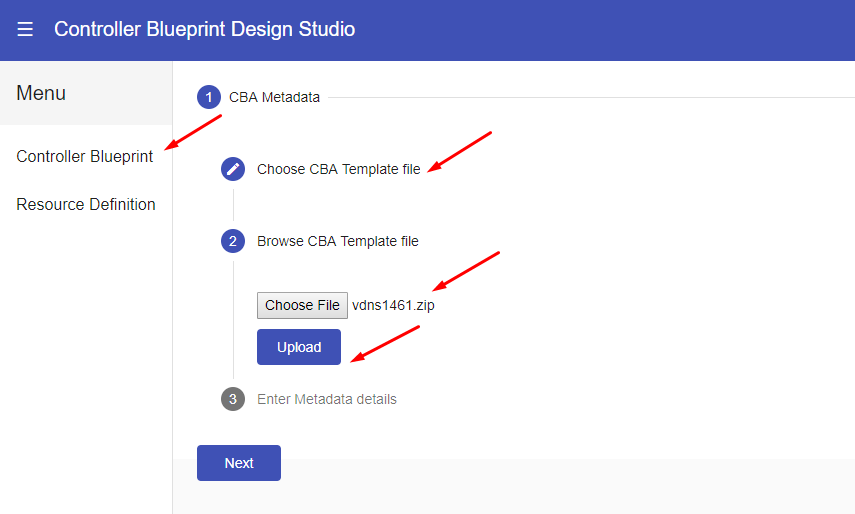


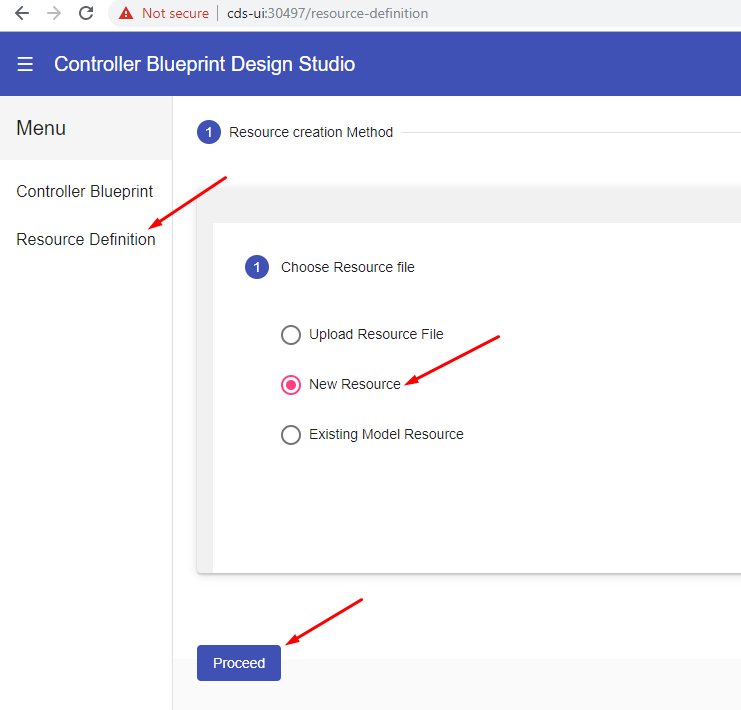



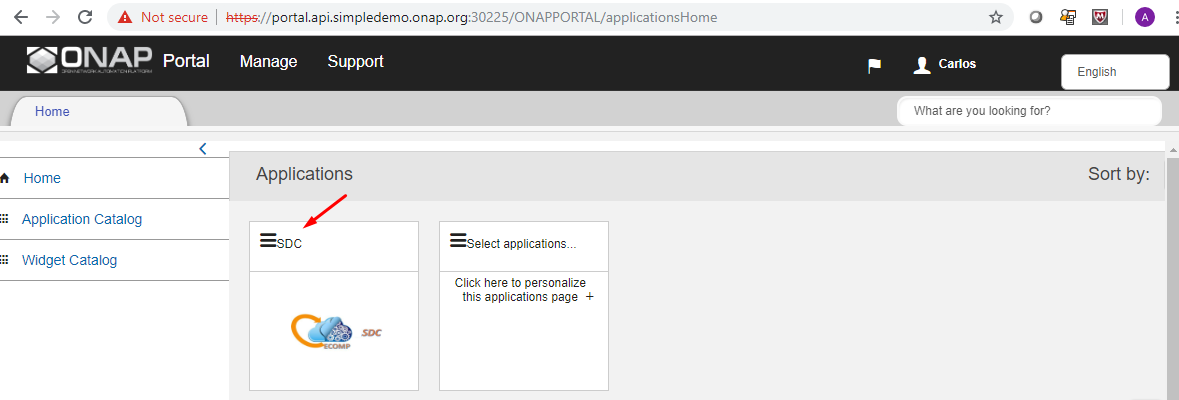




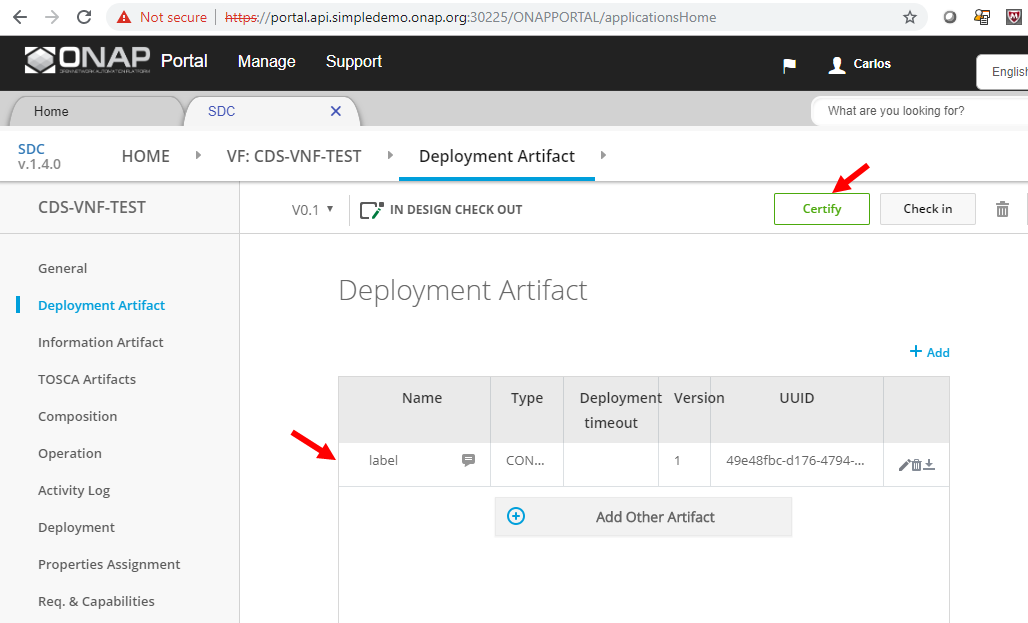
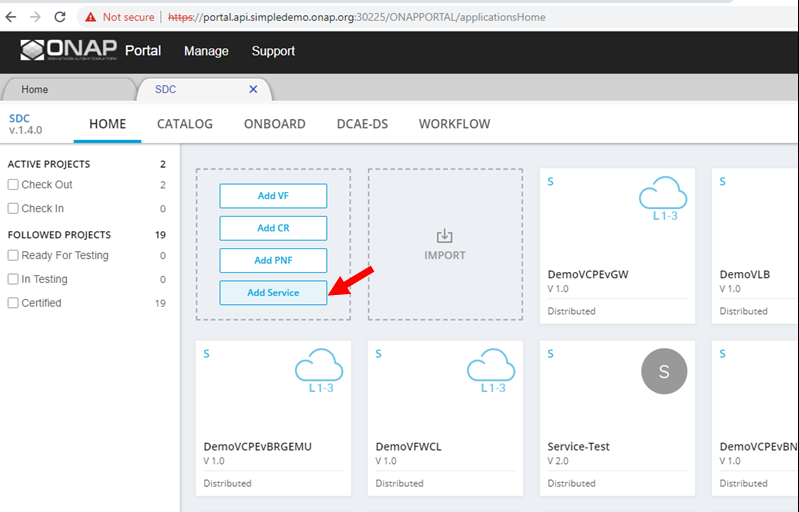

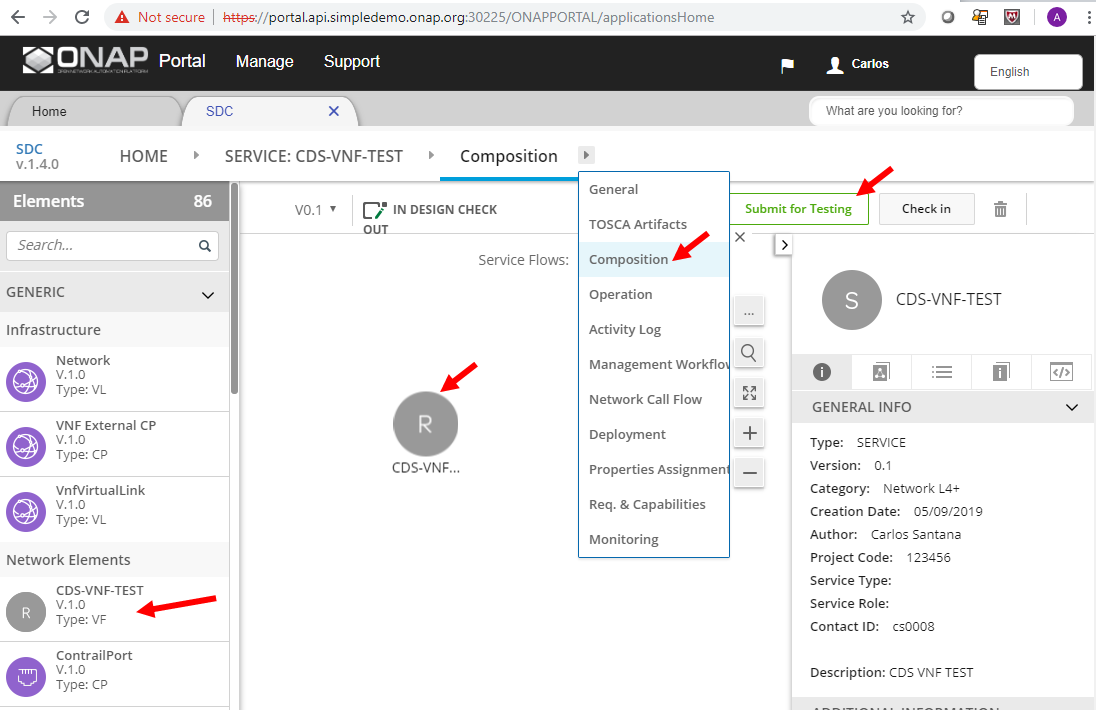
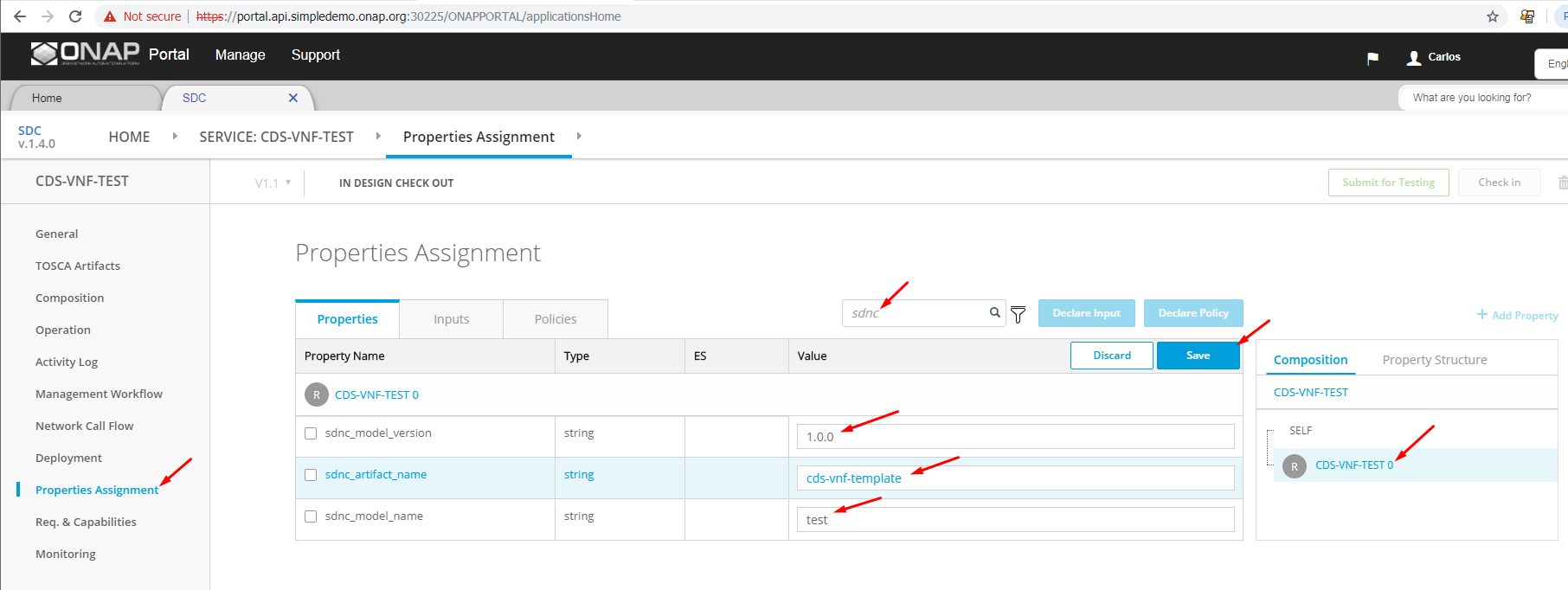



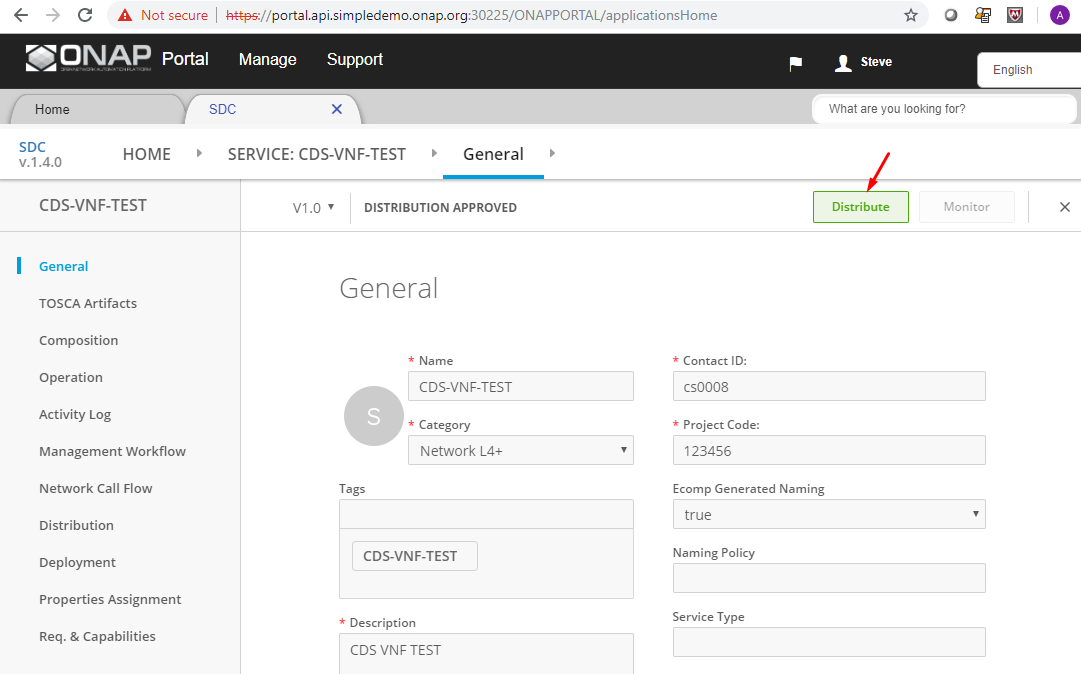

7 Comments
Damian Nowak
I think, it would make sense to name the service like "CDS-VNF-Service", instead of "CDS-VNF-Test".
Currently, the name the of VF resource and Service are the same. Different names would make it clearer, at least to me.
Yuriy Malakov
Damian Nowak You are right, the best practice approach when creating a service within SDC is to append the name of the service with "-Service".
Aniello Paolo Malinconico
Hi all,
can I use custom names for the service and vnf model ? Or It is required to use "CDS-VNF-TEST" and "CDS-VNF-SERVICE" as resources name?
Yuriy Malakov
. CDS-VNF-TEST or CDS-VNF-SERVICE are just for show casing. You can use any custom name for your service.
Aniello Paolo Malinconico
Ok, thanks.
However, I have a distribution error versus the SO.
In the catalogdb → vnf_resource_customization table there are not any rows about the distributed service .
In the so-sdc-controller POD log, I have found this error related to the distribution:
2019-07-04T14:34:13.906Z||pool-4-thread-10|||||ERROR|||processProperties - property nf_function is not found
2019-07-04T14:34:13.906Z||pool-4-thread-10|||||ERROR|||processProperties - property nf_naming_code is not found
2019-07-04T14:34:13.906Z||pool-4-thread-10|||||ERROR|||processProperties - property nf_role is not found
2019-07-04T14:34:13.906Z||pool-4-thread-10|||||ERROR|||processProperties - property nf_type is not found
In fact, in the properties assignement, we have not setted these values...
How can I solve it?
Aniello Paolo Malinconico
Hi All,
I think that the vDNS.zip file is not correct. It is missing some nc-properties files and so, for this reason the distribution versus the SO fails.
Furthermore, creating a vf containing only the CBA is not enought for the deploying of the vdns use case. It should contain the heat template (i.e for vlb,vdns,vpkg) too.
In fact following your procedure, no vnfs are distributed related to my service.
My "correct" procedure for is:
Am I wrong ? If yes, can you explain me better ?Thanks a lot
Damian Nowak
DCAE_INVENTORY_BLUEPRINT artifacts are used for CLosed Loop operations (...they describe the analytics application deployment, which will be used within the CLosedLoop config).
That artifact shall not really be mandatory, unless You want to deploy a ClosedLoop on a xNF used in the service model in the future.